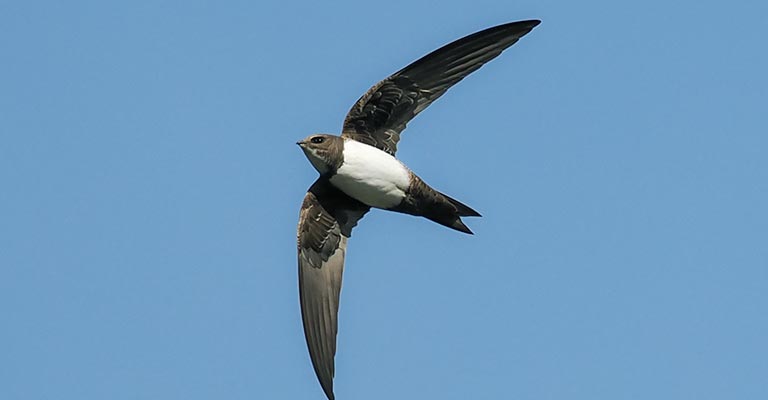The Alpine Swift (Tachymarptis melba) is a remarkable bird species known for its extraordinary flying abilities and elegant appearance.
Found in mountainous regions across Europe, Asia, and Africa, these swifts are recognized for their streamlined bodies, long wings, and distinctive forked tails.
With a wingspan of up to 55 centimeters, Alpine Swifts are highly adapted to a life spent predominantly in the air, feeding on flying insects.
Their mastery of flight is exemplified by their endurance in migratory journeys, covering vast distances during seasonal movements.
These agile birds are also recognized for their communal nesting habits, often choosing cliff faces or other high, inaccessible locations for breeding colonies.
The Alpine Swift remains a captivating subject of study for ornithologists and bird enthusiasts, offering insights into the fascinating world of aerial adaptation and avian behavior.
Identifying Criteria of Alpine Swift

Identifying the Alpine Swift (Tachymarptis melba) requires a keen eye and attention to distinctive features that set this bird apart. Here are eight key points to help enthusiasts and birdwatchers accurately identify the Alpine Swift:
Size and Shape
The Alpine Swift is a medium to large-sized bird with a sleek, streamlined body and long, slender wings.
Its body measures around 20 to 23 centimeters, while its wingspan can reach an impressive 55 centimeters. The wings are swept-back and pointed, giving the bird an unmistakable silhouette during flight.
Plumage Coloration
The Alpine Swift boasts a predominantly dark, sooty brown plumage extending from its head to the tail.
The upperparts are slightly darker than the underparts, creating a subtle contrast. Notably, the plumage lacks the white or pale markings of some other swift species.
Forked Tail
One of the most distinctive features of the Alpine Swift is its deeply forked tail. This unique tail shape sets it apart from other swifts, creating a characteristic “V” pattern in flight.
The tail’s forked appearance is a crucial identifying factor for birdwatchers.
Flight Pattern
Alpine Swifts are exceptional fliers, capable of sustained, agile flight. They exhibit a rapid, direct flight with powerful wing beats, covering large distances during their migratory journeys.
Observing their flight pattern, including the distinct forked tail, is critical to confirming their identity.
Vocalizations
While Alpine Swifts are not mainly known for their vocalizations, they emit high-pitched, screaming calls during specific situations.
These calls may be heard during their aerial displays or around breeding colonies. Familiarizing oneself with these unique vocalizations can aid in identification.
Behavioral Traits
Alpine Swifts are highly social and often form large flocks, especially during migration.
Observing their group behavior, synchronized flight patterns, and communal nesting habits can offer additional clues for identification. Their preference for high-altitude nesting sites is a behavior that sets them apart.
Binocular Observation
Given these birds’ swift and dynamic nature, using binoculars is essential for detailed observation.
The ability to focus on key features such as the forked tail, wing shape, and any subtle markings aids in distinguishing the Alpine Swift from similar-looking species.
Identifying the Alpine Swift requires a holistic approach combining visual observation, knowledge of its distinctive features, and understanding its behavior and habitat preferences.
Aspiring birdwatchers and ornithologists can enhance their skills by paying attention to these eight critical criteria, ensuring a more accurate and fulfilling birding experience.
Taxonomy of Alpine Swift

This table will showcase all the necessary taxonomy details of Alpine Swift:
| Taxonomic Level | Classification |
| Domain | Eukaryota |
| Kingdom | Animalia |
| Phylum | Chordata |
| Class | Aves |
| Clade | Strisores |
| Order | Apodiformes |
| Family | Apodidae |
| Genus | Tachymarptis |
| Species | T. melba |
The Alpine Swift (Tachymarptis melba) belongs to the Apodidae family, characterized by swifts and their close relatives. This species falls under the Tachymarptis genus, which includes swifts known for their exceptional aerial abilities.
As part of the Aves class, it shares common avian traits, and within the class, it is categorized in the Apodiformes order, specifically the Apodidae family. The Tachymarptis melba species is distributed across Europe, Asia, and Africa, thriving in mountainous regions.
Taxonomically, the Alpine Swift is a fascinating example of avian adaptation and evolutionary specialization for a life predominantly spent in flight.
Reproduction of Alpine Swift

Communal nesting habits and a strong focus on high-altitude locations characterize the reproductive process of the Alpine Swift (Tachymarptis melba).
Breeding colonies are typically formed on cliffs, rock faces, or other inaccessible areas, protecting from ground-based predators.
These birds exhibit monogamous mating behavior, with pairs forming strong bonds that can last multiple breeding seasons.
The nesting season usually occurs during the warmer months, with females laying a single egg. Both parents participate in incubation, taking turns to keep the egg warm.
Once hatched, the chicks are fed a diet primarily consisting of regurgitated insects by both parents. Alpine Swifts are known for their synchronized breeding behaviors within colonies, creating a captivating spectacle of aerial displays.
This reproductive strategy and communal nesting contribute to the species’ adaptability and resilience in mountainous habitats.
Alpine Swift Life History

The life history of the Alpine Swift (Tachymarptis melba) unfolds as a fascinating tale of aerial prowess and adaptability.
With its streamlined form and distinctive forked tail, this species navigates the mountainous landscapes of Europe, Asia, and Africa.
From foraging high in the skies to communal nesting on cliffs, the Alpine Swift’s life history is a testament to its resilience in challenging environments.
Food
Alpine Swifts are primarily insectivores, relying on a diet of flying insects captured during their aerial pursuits. Their diet includes airborne prey such as beetles, moths, and flying ants.
These birds are adept at catching insects mid-flight, showcasing their remarkable agility and precision in the air.
Habitat
Mountainous regions characterize the preferred habitat of Alpine Swifts. They exhibit a strong affinity for elevated landscapes, often nesting on cliffs, rock faces, or other inaccessible locations.
These high-altitude habitats provide both nesting sites and optimal conditions for their aerial foraging.
Range Map

The Alpine Swift’s range spans a vast geographical area, encompassing Europe, Asia, and Africa. The species’ distribution is extensive, covering diverse landscapes within its preferred mountainous regions.
The range map illustrates the adaptability of this bird to various environments, emphasizing its ability to thrive in different ecosystems.
Diseases
While Alpine Swifts generally maintain good health, they can be susceptible to avian diseases.
Common avian ailments, including respiratory infections and parasites, may impact their well-being. Monitoring for signs of illness, such as lethargy or changes in behavior, is crucial for early detection and intervention.
Treatment
Treatment for diseases in Alpine Swifts involves a combination of veterinary care and preventive measures. Avian veterinarians may administer antibiotics or other medications based on the diagnosed illness.
Preventive strategies, such as maintaining clean nesting sites and providing a well-balanced diet, contribute to overall health and resilience against diseases.
Conservation
Alpine Swifts face conservation challenges, primarily due to habitat degradation and climate change. Preservation of their mountainous habitats is vital, emphasizing the need for sustainable land management practices.
Conservation efforts should also address potential threats during migration, ensuring the protection of these birds across their extensive range.
Raising awareness about their ecological importance and unique behaviors can foster community engagement in conservation initiatives.
The life history of the Alpine Swift is a testament to the intricate balance between its airborne lifestyle, habitat preferences, and the challenges it faces.
Understanding and appreciating these aspects are crucial for conserving this remarkable species and ensuring its continued presence in the diverse landscapes it calls home.
Nesting Habit of Alpine Swift

Alpine Swifts (Tachymarptis melba) exhibit unique nesting habits, favoring high-altitude locations such as cliffs and rock faces. These birds construct cup-shaped nests using feathers, plant materials, and saliva, creating a secure foundation for their single egg.
Known for communal nesting, colonies of Alpine Swifts engage in synchronized breeding behaviors. Both males and females contribute to incubation and feeding duties, fostering a robust parental bond.
The species displays remarkable adaptability, showcasing its ability to thrive in challenging environments and emphasizing the importance of elevated nesting sites in their reproductive strategies.
| Nesting Aspects | Details |
| Clutch Size | Usually lays a single egg per breeding season |
| Number of Broods | Display high-altitude aerial courtship displays as part of their breeding rituals. |
| Egg Length | Approximately 22 to 25 millimeters |
| Egg Width | Around 14 to 16 millimeters |
| Incubation Period | Roughly 19 to 21 days |
| Nestling Period | Approximately 40 to 45 days |
| Egg Description | White or creamy with a smooth surface |
| Nest Location | Cliff faces, rock crevices, or other high, inaccessible sites |
| Parental Involvement | Both parents take turns incubating the egg and feeding the chick |
| Communal Nesting | Often nests in colonies, exhibiting synchronized breeding behaviors |
| Special Nesting Behaviors | Display high-altitude aerial courtship displays as part of their breeding rituals |
5 Fun Facts About Alpine Swift

The Alpine Swift (Tachymarptis melba) is a captivating bird species known for its exceptional aerial abilities and unique behaviors. Here are five fun facts that shed light on the intriguing characteristics of these high-flying avians:
Endurance Champions
Alpine Swifts are renowned for their extraordinary migratory journeys. They cover vast distances, often flying non-stop for months, showcasing unparalleled endurance and stamina in the air.
Aerial Courtship Displays
During the breeding season, Alpine Swifts engage in mesmerizing aerial courtship displays. These displays involve synchronized flight patterns, showcasing their agility and coordination as they navigate the skies together.
High-Altitude Nests
Their nesting sites are not just chosen for inaccessibility but also for altitude.
Alpine Swifts prefer cliff faces or rocky outcrops, displaying an affinity for high-altitude locations that provide safety and advantageous launch points for aerial pursuits.
Silent Soarers
Unlike other swift species, Alpine Swifts are notably silent during flight.
Their streamlined wings and precise aerodynamics allow them to cut through the air with minimal sound, adding an element of stealth to their hunting and migratory endeavors.
Longevity in Flight
Alpine Swifts spend a significant portion of their lives in the air, even sleeping on the wing during migration.
This unique behavior emphasizes their exceptional adaptation to an airborne lifestyle, demonstrating their ability to thrive where others may struggle.
These fun facts highlight the Alpine Swift’s remarkable attributes, making them a captivating subject of admiration for bird enthusiasts worldwide.
Wrapping Up
The Alpine Swift (Tachymarptis melba) is a testament to nature’s ingenuity, showcasing remarkable adaptations for a life spent soaring in the skies.
From their high-altitude nesting habits to extraordinary migratory feats, each aspect of their biology unravels a captivating story of survival in challenging environments.
The communal nesting behaviors, silent flights, and breathtaking aerial courtship displays fascinate their avian existence.
As stewards of the air, Alpine Swifts continue to inspire awe and curiosity, inviting us to delve deeper into the intricacies of their lives and the ecosystems they inhabit.